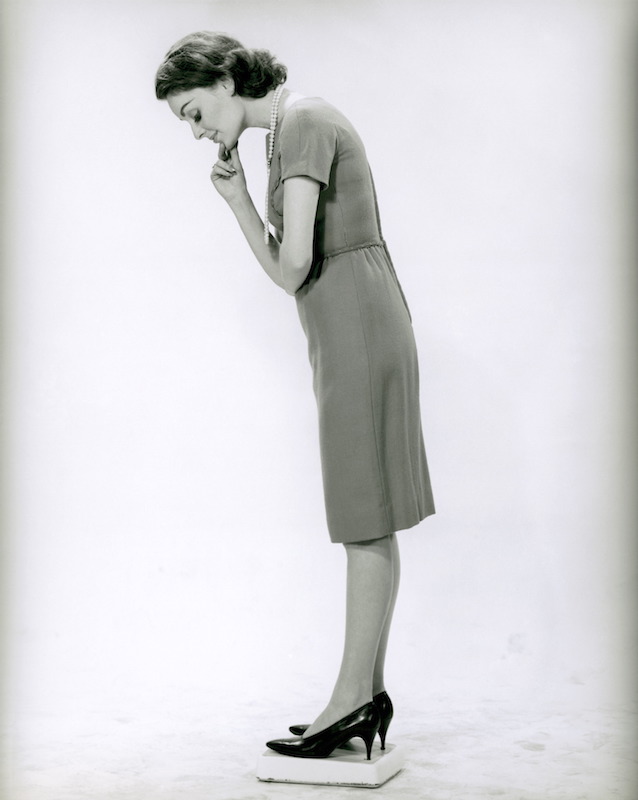
In December 1944, the Associated Press informed people around the world that student Gloria Jeanne Heller had been forced out of Louisiana State University after distributing a leaflet that “advocated free love,” as then-LSU President William Hatcher put it.
Something the AP also relayed: 18-year-old Heller was a “New York-born co-ed. 5ft. 7in. tall and 125 lbs.”
The Washington Post‘s readership learned in May 1946 that Dorothy A. Hargrove, “a green-eyed, blond University of Maryland co-ed,” had been chosen to present colors at a Navy parade the following June. The 21-year-old was “five feet eight and weigh[ed] 121 pounds,” according to the article, again originally from the AP.
Chicago Defender readers were told in August 1961 that Gloria Duncans, a college student studying sociology, was beaten and had her jaw broken by an unidentified man in Ruston, Louisiana. Duncans, the newspaper reported, weighed 105 lbs.
Though it may seem odd today, newspapers from the 1940s, ‘50s and early ‘60s sometimes listed a woman’s weight and physical characteristics, even when such inclusions weren’t significant to the story.
“The description of women by their weight, attractiveness or clothing is fairly well-documented by feminist scholars of mass media and communication,” explains Rosemont College history professor Michelle Moravec, though the printing of a woman’s precise weight is such an extreme example that she says she had “literally never seen” a real-life instance of the practice in her 20 years of research on women in the media. More often, women had their look described with general adjectives like slim, slender or pretty.
In either case, Moravec says, the cause is the same: The practice of including women’s weight — or any other physical observations — in the news has been a way, consciously or not, of “putting women into their proper place,” by giving more value to their appearances. For men, on the other hand, with the exception of athletes, characteristics like weight or attractiveness weren’t important, “Nobody’s describing like, ‘The male candidate in the gray suit got up to deliver a powerful speech,’” she adds. “That’s how you know it’s a gender dynamic: It sounds absurd when you apply it to men.”
Evidence of the movement away from this tradition can be found in the Associated Press Stylebook, which offers journalists a comprehensive set of rules for what to label people and things and how to write about them. The entry on “woman, women,” which continues in today’s editions, stipulates: “Women should receive the same treatment as men in all areas of coverage. Physical descriptions, sexist references, demeaning stereotypes and condescending phrases should not be used.”
The stylebook was first distributed in 1953, and the entry on women was added in 1977, says Norm Goldstein, a co-editor of the book from 1986 to 1989 and its sole editor until 2007. Over the years, the stylebook has made many moves toward what Goldstein calls “linguistic sensitivity” in a number of subjects. Specifically for women, the stylebook “made some conscious affirmative-action changes [in the late 1980s] to assure nonsexist references by using neutral pronouns or female examples,” Goldstein wrote in an email. This included “substituting the name of a female senator or congresswoman, for instance, where we previously used the name of a male counterpart.”
The stylebook’s push against physical descriptions acknowledges that such descriptions were once prevalent. Even so, Goldstein seemed surprised to hear that those descriptions had been so precise, at least in terms of weight. “As far as I know, AP would never — even in the 1940s — accept the use of a woman’s weight in a story,” he wrote, “unless it was newsworthy for some reason.”
That’s the standard of measure that Roy Peter Clark still uses to this day: whether the characteristic falls in line with the driving features of the story. Clark, a senior scholar and vice president at the Poynter Institute for Media Studies, encourages young journalists to write all “the sights, the sounds, the colors” in their notebooks but to include only the pertinent details in the final story. Sometimes physical details do matter — Chris Christie’s weight, for example, in the limited context that voters care about officials’ health — but many are left on the cutting-room floor.
“I’m not saying that [a physical characteristic itself] is news justification for describing the person’s appearance,” said Clark, a journalism educator since 1979. “What I’m saying is that we don’t want to take potential strategies out of the hands of hard-working reporters.”
Things didn’t change overnight to bring the media’s coverage of women where it is today, notes Jennifer Pozner, executive director of the nonprofit media analysis group Women In Media & News. In 1984, when Geraldine Ferraro was the first woman nominated for vice president by a major party, Tom Brokaw introduced her as “size 6.” And in 2000, the New York Times mentioned that newly named national security adviser Condoleezza Rice wore a dress size between 6 and 8. “By the time we learned anything about her national security expertise,” Pozner says, “we’d already left the front page, we’d gone past the jump, deep into the bowels of the paper.”
In 2008, during the presidential race, the candidacies of Hillary Clinton and Sarah Palin brought new attention to the way the media described women in the news. “People finally started to notice that and report about it,” Pozner says, “and I was like, ‘Where have you been?’”
More Must-Reads from TIME
- Donald Trump Is TIME's 2024 Person of the Year
- Why We Chose Trump as Person of the Year
- Is Intermittent Fasting Good or Bad for You?
- The 100 Must-Read Books of 2024
- The 20 Best Christmas TV Episodes
- Column: If Optimism Feels Ridiculous Now, Try Hope
- The Future of Climate Action Is Trade Policy
- Merle Bombardieri Is Helping People Make the Baby Decision
Contact us at letters@time.com